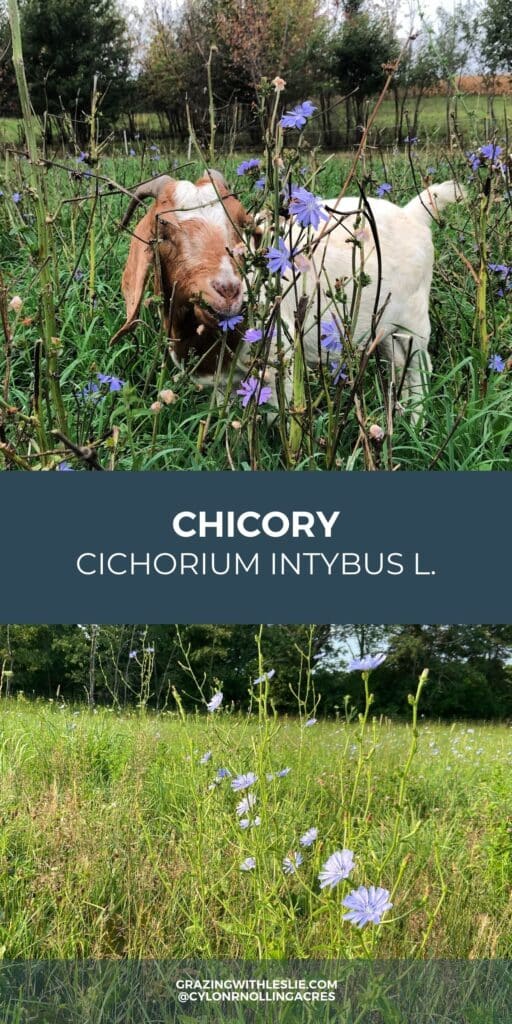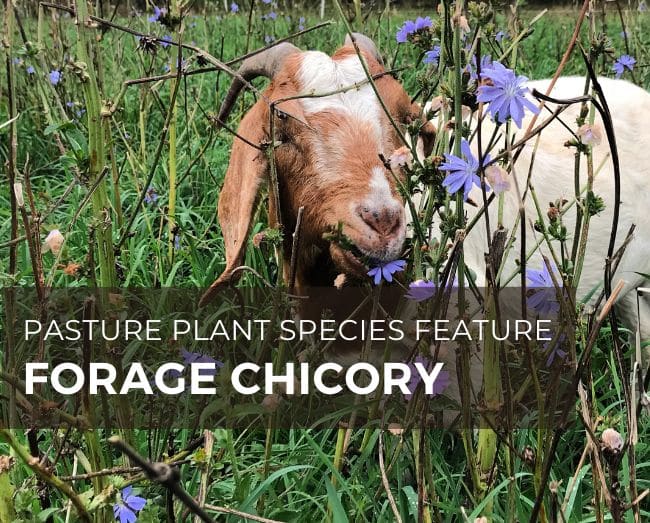Forage chicory is a beneficial plant species for livestock pastures given its heartiness, high nutritional value and anti-parasitic characteristics.
What is chicory?
Chicory has been around for hundreds of years, originating in Europe. It has been a popular coffee substitute, used a a leafy vegetable, and, as discussed in this article, as a nutritional forage option for livestock in pastures.

About the chicory plant
The chicory plant, also known by its scientific name as cichorium intybus L., is a perennial taproot broadleaf herb that is part of the sunflower family. It’s a perennial forb which means it will return year after year for the life of the plant.
Chicory is sometimes also referred to as a blue daisy, blue sailor, wild bachelor’s button, blue or Italian dandelion.
It’s hardy as it is drought tolerant and does well in moderately to well drained soils. Chicory is also rich in minerals and provides high protein forage throughout the growing season.
Chicory seeds are heavier so they move / drop when in contact with animals, humans or equipment, rather than wind, like dandelions do. This means any natural reseeding typically happens near existing plants.
What does chicory look like?
Chicory’s physical characteristics include a leafy bunch at the base with tall, stalky stems growing up to 5-6 feet high with blue flowers. Underground, chicory has a thick, large tap root.
Chicory flower
The chicory flower is blue in color and has a similar appearance to a daisy.
Each chicory blossom only blooms for one day. On hot days chicory flowers may only open for a short duration, while on cloudy or cooler days the flowers are open most of the day.
In the first season of growing chicory won’t produce any flowers, just leaves.
Chicory leaves
Forage chicory leaves are ovate in shape, with some lobbed (or bumpy) characteristics around the end of the leaves.
Chicory wildflower
Chicory wildflower is often confused with forage chicory. However, wild chicory leaves are similar to a dandelion in the rosette stage. This is when the leaves in the circular pattern at the base of the plant. Forage chicory leaves tend to be larger and wider.
Chicory seed
Chicory seed is oblong with a narrower end and wide end with a bristle like appearance.

Chicory benefits for livestock
Chicory provides several benefits as a pasture forage for grazing livestock with its nutritional qualities and antiparasitic properties as well.
Quality feed source
As a component of a pasture, chicory can offer livestock a lot of nutritional benefits.
It is a high quality forage, with crude protein levels ranging from 10-32%. Forage chicory can produce 2-3 tons of dry matter per acre with a new planting and 4-6 tons per acre for established chicory. Digestibility of chicory leaves is around 90%, which is greater than alfalfa.
Chicory also contains high levels of minerals providing livestock with potassium, calcium, magnesium, sulfur, zinc, and sodium.
Once chicory flowers and produces seed, the nutrition quality starts to drop.
Sources: Ohio State, University of Kentucky, NRCS
Antiparasitic properties
Forage chicory is especially appealing for sheep and goat farmers given its antiparasitic properties. It contains sesquiterpene lactones and some condensed tannins, which are compounds that are considered to minimize internal parasite issues with goats and sheep.
A Sustainable Agriculture Research and Education project with Ohio State and several farms demonstrated that lambs grazing chicory had few increases in fecal egg counts compared to the control group.
While more research is needed, the potential for chicory to aid in internal parasite control with small ruminants is there.
Chicory planting: a guide
While chicory planting can happen throughout the U.S., it can be a challenge to establish as a plant species in a pasture or even in a deer food plot.
Site prep for planting
Given its more challenging nature to start growing and getting established, it may be easier to grow chicory in a bare, tilled soil. This helps reduce competition with weeds or existing plant species as chicory starts to grow.
It can be planted with no-till methods or frost seeded but it is more challenging.
Seeding rate
The seeding rate for chicory is:
- 7-10 lb./acre for a pure stand of chicory, which is not very common
- 2-3 lb./acre in a seed mix, which can be reduced if seeded with a legume, such as clover
Planting depth is ⅛ to ¼ inches.
When to plant chicory
While Chicory can be planted throughout the growing season it does better getting established in the spring or early-to-mid fall. It takes roughly 7-21 days for seeds to germinate.
When planting chicory as a new stand in a pasture or food plot, a drill or seed broadcaster works well. If the drill doesn’t have a roller, follow planting with a cultipacker or light drag to ensure the seed to soil contact for proper germination.
To plant chicory into an established pasture, frost seeding or no till methods can be used.
In either case, prep the planting site by mowing the existing stand of plants low or graze it low to reduce competition from existing pasture plant species.
At this point, chicory can be planted with the no till drill.
If a no till drill isn’t available try lightly disturbing the soil with very light discing before planting with a seed drill. Then, follow with a cultipacker or drag.
Chicory frost seeding
For frost seeding, site prep the planting site in the fall before the planned seeding. Frost seeding chicory can be done in early spring when the ground is still frozen. Spread the seed by hand or with a broadcaster.
Seed mixes
Chicory is more commonly used in a forage seed mix rather than planted as a single species. It does well planned with legumes since legumes have the ability to fix nitrogen.
Clover chicory mix
A popular chicory/legume combination is a clover chicory mix. Since clover is a legume it naturally fixes nitrogen, converting nitrogen from at the atmosphere into available nitrogen which also benefits chicory. This means synthetic fertilizer isn’t needed since the clover is helping providing the nutrients to the soil.
Clover can help reduce any frost heaving, where the chicory plants are pushed up out of the ground after winter from the frost. Companion planting with clover also reduces weed competition with chicory.
Chicory and Clover Seed Mix Planting Rates
| Seed mixes and rates (lb./acre) | Chicory | Clover |
|---|---|---|
| Chicory with red clover | 4 to 5 | 6 to 8 |
| Chicory with white clover | 4 to 5 | 3 to 4 |
Source: University of Kentucky
Managing new chicory planting
A new stand, or chicory planting, can be grazed after 90 days. Be sure to not over-graze or the plant growth will be stunted or possibly not regrow in subsequent seasons.
Stand life
The lifespan of chicory ranges from 3-7 years. If it is well managed, including not being over grazed, forage chicory can last on the longer end of this range.
Grazing strategies with chicory
Chicory ideally should be grazed at about 8-10 inches high, when the plants are in their vegetative growth stage. Avoid overgrazing by using the general rule of thumb of graze half, leave half.
Like many plant species, once chicory flowers, its forage quality starts to drop. Keep this in mind as you manage and graze pastures with chicory.
Wait at least 30 days before returning to graze the chicory based on plant regrowth and the parasite cycle if you’re grazing small ruminants, such as goats and sheep.
Chicory with goats and sheep
We’ve interseeded forage chicory into our goat and sheep pastures on our farm, Cylon Rolling Acres. The three main reasons include its:
- Heartiness to grow throughout the growing season. Even in our summer slump of pasture growth, our chicory is still going strong.
- High quality nutritional value for feed and available minerals
- Anti parasitic characteristics, which are important with small ruminants and parasite management challenges
We established chicory into our pastures after grazing low with our goats. We lightly tilled the soil with a disc the soil to maintain the existing pasture but allow for better seed to soil contact when planting with a traditional seed drill and drag. This was before we owned a no-till drill.
Chicory for deer food plots
Chicory is a common plant species used with deer food plots or other wildlife plots for grouse and even turkeys. It is commonly paired with seed mixes that include clover, among other plant species.
When to plant chicory for deer
It’s ideal to plant chicory for deer in the fall to establish the plant when there’s less competition with new weed growth.
It has a preference for full sun so avoid planting chicory in the woods where there’s a heavy tree canopy with a lot of shade.
Managing deer chicory plots
Deer chicory plots may need to be mowed during the summer 2-3 times to stop the plant from flowering, which reduces the nutritional quality. Mowing at 8-10 inches or before flowering is best. This will encourage regrowth throughout the growing season.
References
- Hancock Seed Company. Chicory Seed.
- Ohio State University Extension. (2012). Use of forage chicory in a small ruminant parasite control program.
- Penn State. (2021). Chicory – Weed or flower?
- SARE. (2012). Researchers study forage chicory for parasite reduction in sheep.
- University of Kentucky. (2007). Chicory: An alternative livestock forage.
- USDA NRCS. (2003). Illinois Grazing Manual Fact Sheet: Chicory.

LEAVE A COMMENT
Comments